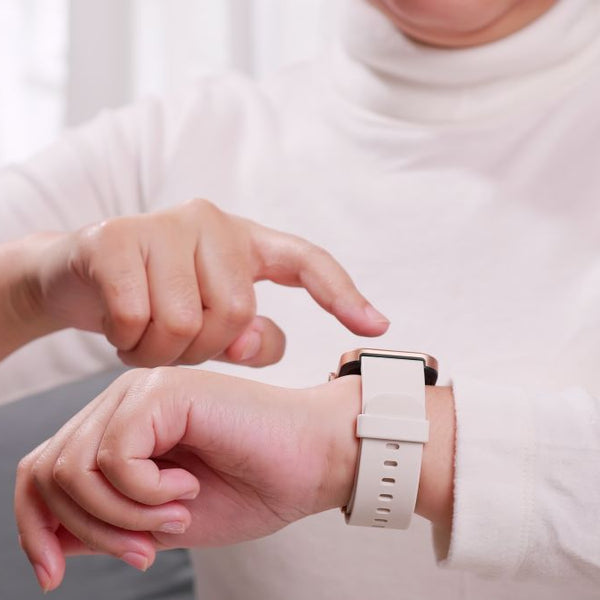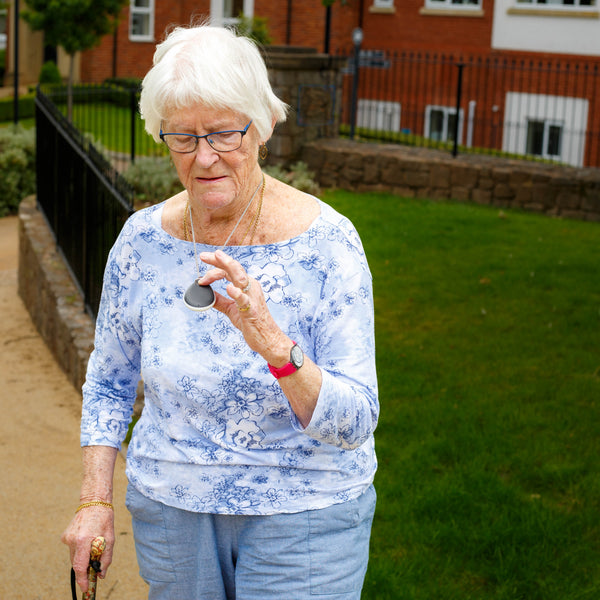As our loved ones age, we often worry about their safety, especially if they live alone. Personal alarms that contact family and friends or a specialist call centre provide a practical solution for emergencies, offering peace of mind to both older adults and their families.
Personal alarms, also known as panic buttons or emergency alarms, are small wearable devices that provide immediate assistance during emergencies. With a single button press, these devices alert pre-set contacts or a 24/7 monitoring team. They come in various forms, such as pendants or wristbands, and are especially valuable for older adults that live alone or have a history of falls, health emergencies, or accidents in and around the home.
In this article, we compare monitored alarms that contact a call centre with devices that call friends and family. We will look at why mobile phones may not be the best option in emergencies, and highlight the benefits of 24/7 monitored alarms to help you make an informed decision.
With so many options available, finding the perfect alarm can be challenging. Each device offers different features and costs, and family members may worry about choosing one that might fail in an emergency. Additionally, elderly loved ones may resist using a panic button, making the conversation about safety and independence more delicate.
Quick comparison of solutions
If you're short on time, this table highlights the key differences between the main types of personal alarms and emergency devices.

There are two main types of panic buttons:
- Unmonitored panic buttons: These personal alarms contact friends and family and rely solely on pre-set emergency contacts instead of a monitoring centre.
- Monitored panic buttons: These connect to 24/7 emergency monitoring centres, which can contact family, friends, or emergency services as needed.
Unmonitored alarms that contact family and friends
Panic buttons that contact family and friends connect the wearer directly to a list of pre-set contacts during emergencies. They may initiate calls, send text messages, or trigger app notifications, depending on the features of the device.
These devices can use landline connections or operate through a SIM card. Some models also provide GPS location data to help family members respond quickly.

Benefits of panic buttons that contact family and friends
- Direct communication with family: These alarms connect wearers with familiar voices during vulnerable moments, providing reassurance and recognisable support.
- Personalised contact list: Users can save trusted contacts, including neighbours, if family members live far away.
-
Cost-friendly: Unmonitored alarms are usually a one-time purchase, as there is no subscription fees. This makes them a budget-friendly choice.
Concerns with panic buttons that contact family and friends
- Reliance on emergency contacts: Family and friends may be unavailable or miss alerts, potentially delaying help. Contacts may be working and unable to respond or if it is late at night, they may be asleep and miss the call.
-
Lack of professional support: These alarms don’t provide access to trained professionals who can assess emergencies and decide on the best course of action.
Why not just use a mobile phone in an emergency?
Mobile phones are essential for communication, but they have limitations in emergencies, particularly for older adults.
Challenges of using a mobile phone
- Accessibility issues: Phones may not always be within reach, especially during emergencies like a fall or sudden health scare.
- Ease of use: Older adults may find smartphones difficult to operate due to small buttons or complicated interfaces, particularly in stressful situations.
- Battery life: Phones need regular charging, and a dead battery could leave the user without help when needed.
- Reliance on coverage: Poor signal areas can prevent calls from going through, leaving users stranded during critical moments.
Mobile phones v personal alarms
For more information about the pros and cons of mobile phones in an emergency, read our comparison of mobile phones and personal alarms.
Why should you choose a monitored panic button?
Monitored panic buttons offer unmatched reliability and peace of mind for both older adults and their families.
Benefits of monitored panic buttons
- Immediate access to help: Trained professionals respond promptly, minimising delays in emergencies.
- Reliable support 24/7: Monitoring centres provide continuous coverage, even during holidays or late at night.
- Professional emergency management: Operators assess situations calmly and efficiently, contacting emergency services or family members as needed.
- Reduces stress and anxiety: Knowing help is always available alleviates worries for both the wearer and their loved ones.
-
Additional features: Monitored emergency buttons and fall alarms often come with extra functionality like automatic fall detection and GPS tracking.
Why monitored panic buttons are better than mobile phones
- Ease of use: With a single button press, users can call for help. Some devices even include automatic fall detection.
- Wearable and accessible: Designed to be worn as pendants or wristbands, these alarms are always within reach.
-
Long battery life: Many devices have batteries lasting 2-5 years and include low-battery warnings.
How to talk to Mum or Dad about getting a personal alarm
We’ve put together a step-by-step guide to help you talk to your elderly loved ones about the benefits of having a personal alarm.
Added peace of mind with a Taking Care alarm
Taking Care offers a range of panic buttons tailored to different needs. These personal alarm devices are simple to use and monitored 24/7, ensuring help is always available. Whether your loved one needs a basic alarm or advanced features like GPS tracking, Taking Care provides reliable solutions to help them stay safe and independent.
Compare personal alarms or call our Independent Living Advisors on freephone 0800 085 7371 Monday - Friday, 9am - 5pm.






